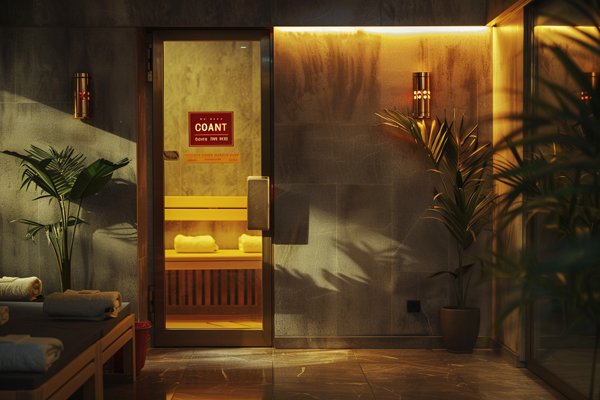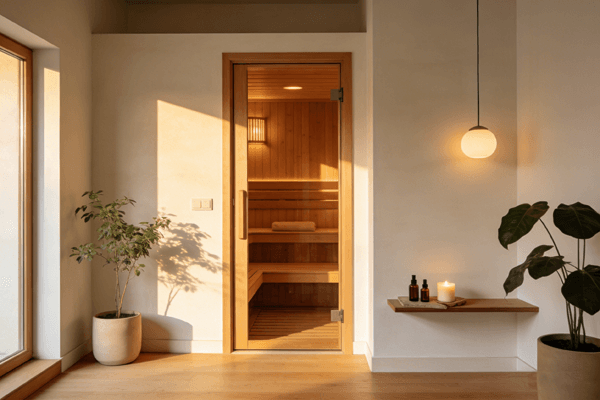The decision between a hammam and a sauna can be overwhelming. Both offer unique experiences and health benefits. Choosing the right one depends on your personal preferences and wellness goals.
Both hammams and saunas promote relaxation and wellness but differ in experience and benefits.
Take a deeper look to understand which suits you best and make an informed decision.
What Is the Difference Between a Hammam and a Sauna?
Hammams and saunas may seem similar at first glance. However, they differ significantly in origin, style, and purpose, hammams and saunas1.
Hammams, or Turkish baths, offer a steam-based experience, while saunas are dry-heat rooms originating from Nordic cultures, steam-based experience and dry-heat rooms2.
Hammams are typically made of marble with flowing water, creating a moist environment. Saunas, on the other hand, use wooden interiors to maintain a dry atmosphere.
Cultural Roots
- Hammams: Middle Eastern tradition emphasizing cleansing and socializing.
- Saunas: Nordic roots focusing on relaxation and health.
| Feature | Hammam | Sauna |
|---|---|---|
| Heat Type | Wet steam | Dry heat |
| Interior Design | Marble and water basins | Wood and heaters |
| Social Aspect | Communal and interactive | Solitary or private |
How Do Hammams and Saunas Differ in Function and Temperature?
The functional differences between hammams and saunas are tied closely to their heat and humidity levels.
Hammams operate at lower temperatures (40-50°C) with 100% humidity, whereas saunas can reach 80-100°C with much lower humidity, lower temperatures and 100% humidity3.
Temperature and Humidity Comparison
- Hammams provide a gentler experience suitable for beginners or those sensitive to heat.
- Saunas offer intense heat, which some prefer for deep relaxation.
Key Advantages
- Hammam: Gentle on skin and respiratory system.
- Sauna: Promotes detoxification through sweating.
What Are the Benefits of Hammams and Saunas for Skin and Mental Health?
Both hammams and saunas offer impressive benefits for both physical and mental health, impressive benefits for both physical and mental health4. They promote relaxation, improve circulation, and support skin health.
Hammams are excellent for deep cleansing, while saunas excel in stress relief and detoxification.
Skin Benefits
- Hammam: Moist steam softens skin, opening pores for deep cleansing.
- Sauna: Dry heat flushes out toxins through sweat, enhancing skin clarity.
Mental Health Advantages
Hammams create a calming atmosphere, while saunas stimulate endorphin release. Both reduce stress and improve mood.
| Benefit | Hammam | Sauna |
|---|---|---|
| Skin Cleansing | Deep exfoliation | Detox through sweating |
| Mental Well-Being | Relaxation and calmness | Stress reduction |
How Long Should a Sauna or Hammam Session Last?
Spending the right amount of time in a hammam or sauna is crucial for reaping their benefits without overexerting your body, right amount of time in a hammam or sauna5.
Hammam sessions typically last 30-60 minutes, while sauna sessions are shorter, around 10-20 minutes per round.
Session Guidelines
- Alternate between heat and cooling periods in saunas.
- Use the hammam's cooling room to transition gradually.
Both require hydration before and after the session to prevent dehydration.
How to Maximize the Benefits of a Sauna or Hammam Experience?
To get the most out of your hammam or sauna experience, you need to follow certain practices.
Prepare your body beforehand, use the facilities mindfully, and ensure proper post-session care.
Preparation Tips
- Stay hydrated.
- Avoid heavy meals before the session.
Post-Session Practices
- Hammam: Moisturize skin to lock in hydration.
- Sauna: Rest and rehydrate with electrolyte-rich drinks.
What Precautions Should You Take When Using a Hammam or Sauna?
While hammams and saunas are beneficial, certain precautions are necessary to ensure a safe experience.
Avoid extended sessions, hydrate adequately, and consult a physician if you have health conditions6.
Safety Tips
- Limit sessions to avoid overheating.
- Take breaks between rounds in saunas.
- Avoid both if pregnant or with cardiovascular conditions.
Conclusion
Both hammams and saunas offer unique experiences that cater to different wellness needs. Hammams provide gentle, cleansing relaxation, while saunas offer intense detoxification and stress relief. The choice depends on your preferences and goals.
-
Learn about the cultural roots and distinctions of these wellness practices. ↩
-
Explore the key differences in heat types and benefits. ↩
-
Understand how temperature and humidity impact the experience. ↩
-
Discover how these practices improve your overall wellness. ↩
-
Learn the recommended session durations for optimal benefits. ↩
-
Stay safe by understanding necessary precautions. ↩















